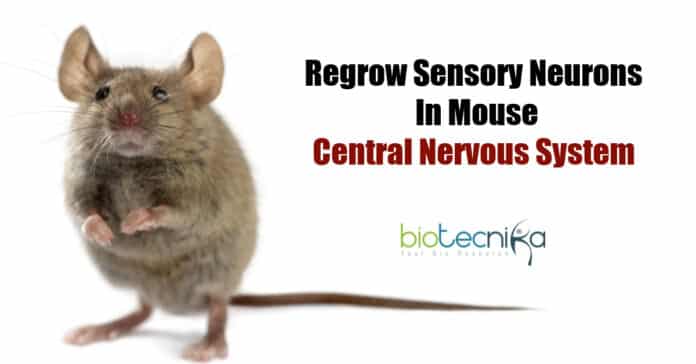Regrowing sensory neurons in mouse’s CNS
A spinal cord injury disrupts communication between the body and the brain, impairing the signals that control sensation and movement. As the injured motor and sensory neurons in the CNS (brain and spinal cord) have a confined capability to repair themselves, individuals who sustain such injuries may experience chronic paralysis, pain, and numbness.
Scientists at Washington University School of Medicine, St. Louis, discovered a drug that aids in the healing of sensory neurons in the central nervous system (CNS). Support cells surround the neurons to protect and nourish them. For this research, the team administered fenofibrate, a drug authorized by the FDA to treat high cholesterol, to mice with injured sensory neurons. The drug activated the support cells surrounding sensory neurons, allowing them to regrow roughly twice as quickly as sensory neurons in mice administered with placebo. The outcomes of the study are issued in eLife.
Senior authors Valeria Cavalli, Ph.D., Prof. Robert E., and Prof. Louise F. Dunn stated that while somebody thinks of spinal cord injury, they think of paralysis. However, there are many other difficulties with sensory processing and pain after spinal cord injury. Focusing on those sensory issues could help towards improving survivors’ quality of life. The findings suggest that fenofibrate has the potential to stimulate these support cells and promote recovery, implying that this FDA-approved compound could be possibly repurposed to aid in the restoration of sensory function following nerve injuries.
Sensory nerves in the periphery of the body recuperate after injury, unlike neurons in the brain or spinal cord, which is why a gash on your leg does not leave part of your leg numb forever. Cavalli studies sensory neurons of the dorsal root ganglia to learn why regeneration occurs in the peripheral nervous system but not the CNS. The cell bodies of such neurons form a structure referred to as a ganglion, which is located just outside the spinal cord.
Each cell body has a long, thin arm named an axon that branches out in opposite directions, one into the CNS via the spinal cord and the other into the peripheral nervous system as it descends into the body. The peripheral and central axonal branches, in spite of being two parts of the same cell, don’t react to injury in the same way. The peripheral parts regenerate and heal much more quickly and thoroughly than the central ones.
Cavalli and Oshri Avraham, Ph.D., first author and a staff scientist, hypothesized that the variations in regeneration between the two branches were due to variations in the behavior of support cells in response to injury to central versus peripheral axon branches.
To study this instance, the team compared gene expression in 5 types of support cells in the ganglion after injury to the sensory neuron’s peripheral and central branches. They discovered that gene expression patterns in support cells differed based on which part of the neuron was injured. Most noticeably, only after an injury to the peripheral axon branch did so-called satellite glial cells increase the expression of a set of genes called the PPAR-alpha pathway, which is recognized for its function in fat metabolism. After an injury to central axonal branches, the pathway was not turned up, and after spinal cord injury in the CNS, it was actually dialed down.
This observation suggested to Cavalli and Avraham that the PPAR-alpha pathway may stimulate regeneration. To uncover it, the researchers fed mice fenofibrate, a PPAR alpha activator, for 2 weeks before injuring the mice’s sensory axon branch leading into the CNS. 3 days after the injury, the central branches of the sensory neuron axons had regrown roughly twice as much in the fenofibrate-treated mice than the placebo-treated mice.
Cavalli stated that as PPAR alpha is only expressed in satellite glial cells and not neurons, these findings suggest that targeting these support cells can promote regeneration and probably relieve sensory signs like pain. It provides us with a new tool for developing therapeutics to recover function after nerve injuries. However, spinal cord injury is not yet confirmed, but it’s not too far.
The team is now mapping experiments to link fenofibrate with other experimental regeneration-promoting therapeutics targeting neurons or other aspects of the CNS in order to boost regeneration even further.
Also Read:
-
One-shot Sputnik Light Shows 70% Potency Against Delta SARS-CoV-2
-
Understanding DNA Repair Mechanism Might Lead To Improved Cancer Therapies
-
How Brain Cells Repair Their DNA Exposes ‘Hot Spots’ Of Aging And Disease
Download Biotecnika App for more Updates on Life Sciences, Job vacancies, CSIR-NET, GATE, and a lot more.
Keyword: Regrowing Sensory Neurons In Mouse’s Central Nervous System; Regrowing sensory neurons.



